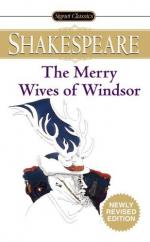|
This section contains 4,730 words (approx. 16 pages at 300 words per page) |

|
SOURCE: "Double Plots in Shakespeare," in Shakespeare and the Traditions of Comedy, Cambridge University Press, 1974, pp. 228-38.
In the following excerpt, Salingar discusses possible influences on and sources for Shakespeare's The Merry Wives of Windsor. The author contends that the play is a classic example of "the duper duped," as almost everyone in the play is deceived.
A Midsummer Night's Dream marks the end of the first phase in Shakespeare's writing of comedies, when one of his main interests is to devise an intricate plot. In most of his later comedies mere intricacy of plot is less important, though of course it is still present, and Shakespeare still applies the Italian principle of the double plot, as for instance in Much Ado, where he carefully interweaves his borrowed intrigue, the slander of Hero, with his invented intrigue, the deception of Beatrice. But The Merry Wives of Windsor shows...
|
This section contains 4,730 words (approx. 16 pages at 300 words per page) |

|


